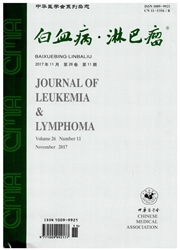

 中文摘要:
中文摘要:
目的:观察急性白血病患者接受异基因造血干细胞移植后Epstein-Barr病毒(EBV)血症的发生率,筛选其发生的高危因素,并评估EBV血症对移植预后的影响。方法:收集2012-01-2014-06于本中心接受异基因移植的急性白血病患者共501例的临床资料进行统计学分析,EBV血症检测采用实时定量PCR法检测外周血标本。结果:急性白血病患者移植后EBV血症2年累积发生率为22.1%±1.9%,不同类型白血病间发生率差异无统计学意义(P=0.406)。多因素分析结果显示,预处理中应用抗胸腺细胞球蛋白和单倍型供体是影响EBV血症发生率的独立危险因素。移植后EBV血症阴性和阳性患者2年总生存率分别为64.1%±2.3%和67.7%±5.7%,无白血病生存率分别为61.6%±2.3%和63.1%±6.0%,复发率分别为19.2%±2.1%和18.9%±5.3%,非复发死亡率分别为28.0%±2.2%和23.3%±4.3%,差异均无统计学意义。结论:EBV血症是急性白血病患者异基因移植后较为常见的并发症,预处理中应用抗胸腺细胞球蛋白和单倍型供体可显著升高EBV血症的发生率。通过积极监测及治疗,EBV血症不会显著降低移植预后。
 英文摘要:
英文摘要:
Objective:To access the incidence,predictive factors and outcomes of Epstein-Barr virus(EBV)viremia for acute leukemia patients who have received allogeneic hemamtopoietic stem cell transplantation(alloHSCT).Method:Clinical data of 501 patients with acute leukemia who underwent allo-HSCT from January,2012 to June,2014 were analyzed.EBV-DNA level in peripheral blood was detected by QT-PCR.Result:Two-year incidence of EBV viremia was 22.1%±1.9%,with no significant differences among different subtypes(P=0.406).Multivariate analysis revealed that both the application of ATG in conditioning and haploidentical donor were independent risk factors affecting the incidence of EBV viremia.No statistical significance was identified when comparing the 2-year overall survival between EBV viremia-negative and-positive patients(64.1%±2.3% vs.67.7%±5.7%),as well as leukemia-free survival(61.6%±2.3% vs.63.1%±6.0%),relapse incidence(19.2%±2.1%vs.18.9%±5.3%)and non-relapse mortility(28.0%±2.2% vs.23.3%±4.3%),with all the Pvalues〉0.05.Conclusion:EBV viremia is commonly detected in acute leukemia patients post allo-HSCT,and the application of ATG in conditioning and haploidentical donor may increase the incidence.However,transplant outcomes will not be deteriorated through regular monitoring of EBV-DNA load and preemptive treatment.
 同期刊论文项目
同期刊论文项目
 同项目期刊论文
同项目期刊论文
 期刊信息
期刊信息
